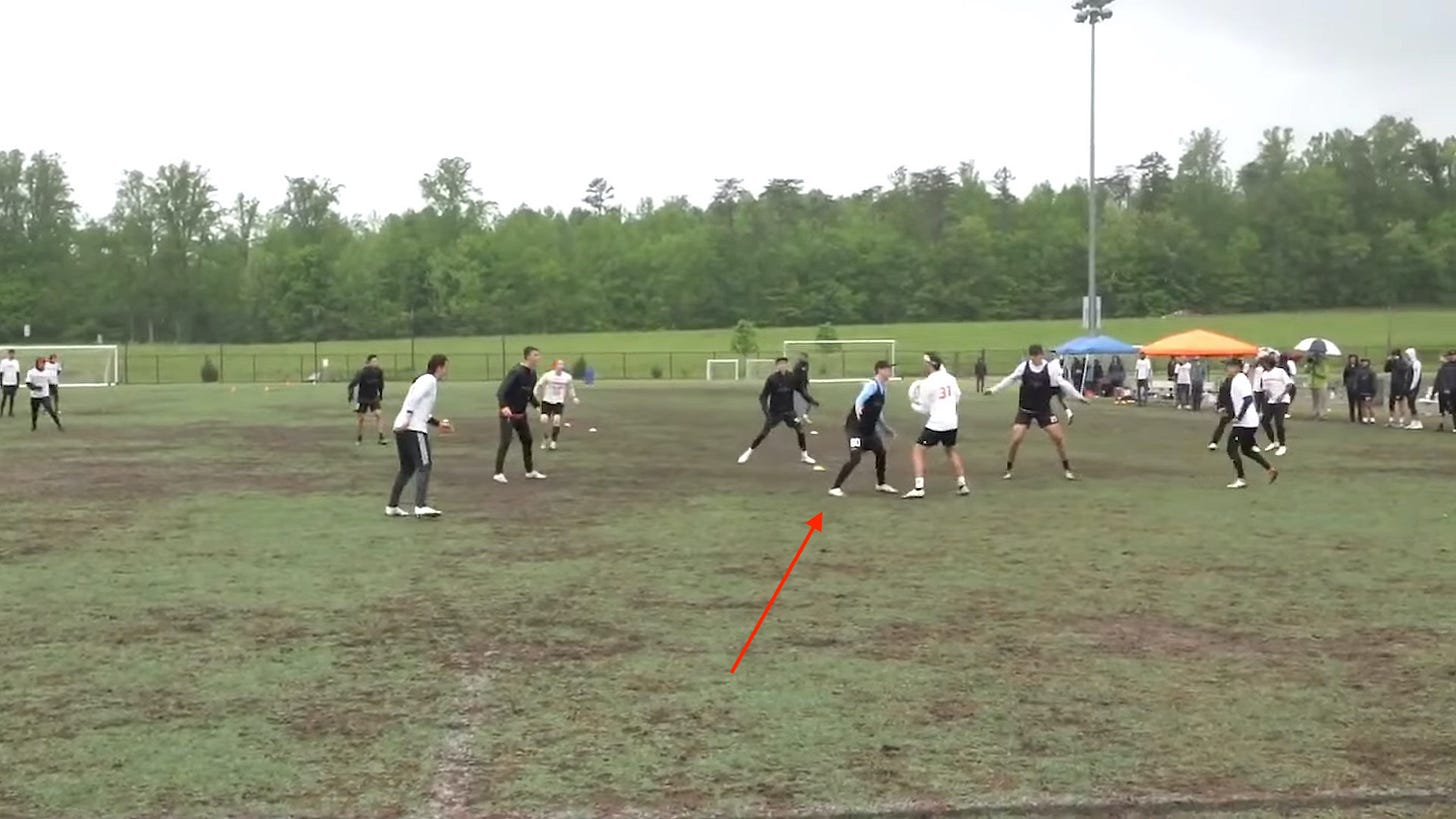How to get handblocks like John McDonnell
Analyzing the best highlight video I've seen recently
I was incredibly impressed by the John McDonnell highlight video posted to Reddit recently. I'm not sure I've caught a Callahan in my entire career; he's caught 4+ on video in just a few years:
The best part of the video is the insane number of handblocks he gets.
A friend once asked if I'd write about handblocks. I never planned to because I had nothing unique to say. To be honest, if I were to write about handblocks the first thing I'd write would be to put less effort into getting handblocks. Too many people get themselves out of position trying to stop a pass that they're not going to stop anyway.
Without my own theories on handblocks, perhaps the best alternative is to study someone who's extremely good at getting them.
Certainly McDonnell has some natural factors that give him an edge. He's tall, and height is impossible to train. He's quick, too—quickness isn't easy to train, but most of us can make some progress if we practice being quick in the right ways. It's hard to say which factors I'll point out below could generalize to other players, and which are him taking advantage of his own unique skills.
Here's what stood out when I watched the video closely:
Three categories of blocks
First thing I notice: McDonnell's handblocks fit into three roughly equal-sized categories:
Blocks intercepting very short dump passes (6 blocks)
See 0:27, 0:57, 2:12*, 3:09, 3:27, and 3:42
*He might actually be guarding the cutter here, not markingBlocks on high release (backhand) throws (7 blocks)
See 0:09, 0:41, 0:45, 0:50, 1:13, 2:09*, 4:20
*This one might be a scoober, but the release point is identical to a high release backhandEverything else (5 blocks)
See 0:42, 0:46, 0:49, 2:07, 3:24
A few low release backhands, a low release forehand, etc.
This is the most striking takeaway to me: 70% of his handblocks come from very two specific types of play: blocking high release backhands, and jumping to intercept very short dump throws.
Again, it's hard to say if he's found an advantage that only he can exploit, or if this is something we can all learn from. I prefer to think he's noticed a few little tricks that we can all take advantage of—areas where throwers are consistently exposing themselves to handblock opportunities by being less vigilant than they really need to be. I will be more aggressive attempting handblocks in these two situations, without increasing my handblock aggression across the board.
(And if you're someone who'll be playing against John McDonnell, you now know which throws to be extra careful about. Avoid these situations unless you're extremely confident you can avoid the mistakes that got these opponents featured in his highlight video.)
Let the thrower see the lane
As I said above, I'm not a handblock theorist. But to the extent I did have a technique, it was this: let the thrower see the open throwing lane that you want to get a block in.
If a thrower can see your hand in the way, they are going to try to throw around your hand. But if they can see an open throwing lane, they'll be tempted to throw into it. When a thrower throws around your already-outstretched hand, you don't have much extension left to reach even further to block the pass. But if your hand is less than fully extended, there's a better chance to reach out quickly without needing to over-extend yourself.
McDonnell's handblocks on high releases are a perfect example of this strategy. He doesn't get handblocks on high release passes by keeping his hands high. His hands are at a normal height, and then flash up quickly after the thrower starts their motion.
For example, here's one block turned into a simple GIF:
And another:
One thing I'd like to point out about this example: the thrower noticeably taller than him.
And another:
Again, his hand never starts anywhere near where he makes the block. The thrower can see the lane, but McDonnell is quick enough to take it away.
The metaphor is lying in wait and pouncing, like a tiger or a striking snake. It's not spreading your wings and getting huge like a bird trying to scare off something it feels threatened by.
Athletic position (and more)
A few other quick thoughts:
I've never been a fan of waving your arms around willy-nilly as a mark, and McDonnell doesn't use this technique either. I'm not saying this technique completely useless, as the point isn't to get handblocks. Arm-waving is (I assume) meant to distract the thrower, make them feel uncertain, and make it difficult for them to see the field behind you. So it's reasonable that a handblock expert doesn't use this technique, since he's working towards a different goal.
Another thing I notice is that he doesn't mark aggressively close. Obviously there are a number of factors that could play into choosing how close we mark. Further away, there are more angles for the thrower to throw around us. Closer, the thrower is more likely to feel uncomfortable simply due to our presence. If we're too close to the thrower, it can be tough to quickly take in the 'big picture' view of their stance (just as sitting too close to the screen at the movies makes it hard to watch).
A little distance gives us the space to quickly observe & adapt to the thrower's eyes, hand, and footwork at the same time. I'm a well known fan of being observant, and mark defense is another example—staying just far enough away allows McDonnell to take in the thrower body position, eyes, and footwork all with one glance. I believe that being clued into all of that information as early as possible allows him to make quick decisions and get his hands into the right spot sooner than other defenders can. A thrower's decision to throw a high release backhand may be revealed by the movement of their non-pivot-foot before it's revealed by where they move the disc.
The last point I'd like to make is that McDonnell is consistently in an athletic position on the mark—in other words, he's on his toes, with his knees a bit bent and his feet a reasonable distance apart. I'm sure it won't surprise fans of this blog to learn that I think footwork is a critical part of what McDonnell does with his hands.
In a way, staying in athletic position is another example of the idea of letting the thrower see the throwing lane — when you keep your knees bent, you let the thrower see throwing lanes that you can explode into by straightening out your legs.
But more generally, a good athletic position allows him to make small quick adjustments while marking without getting off-balance. Staying balanced and ready keeps him in position when handblock opportunities do arise.
Check out the bent knees in a few of these screenshots:
Final thoughts
This great highlight video renewed my interest in playing good defense on the mark, and I'll be focusing on building my skill & consistency in a few areas:
Being in an athletic position so I stay balanced & ready to strike
Hunting block opportunities on (a) high release backhands and (b) super short, dishy dump passes
Letting the thrower see the open throwing lane and only shooting my hand into it at the last moment
And I'll keep my high release backhands far away from this bad, bad man.








